This soothing and moisturizing nettle oil may ease your stiff joints or enhance your skin and hair. Made of nettle leaves and carrier oil, this stinging nettle oil might help with skin irritations or baldness.
In the spring, I often walk around the small lake in our neighborhood with scissors, gloves, and a small basket for a few plants of nettle to add to my morning smoothies or soup.

It is my ritual just to activate my metabolism and detox my body after a long winter and prevent spring fatigue.
Now is autumn and I still go to my favorite place equipped with the same tools for nettle leaves. However, this time, I gather the nettle leaves to use on my skin and hair.
With the fall, I noticed pronounced hair loss, and I got scared I was going to end up bald soon. So I went to my books to learn that nettle makes miracles on hair.
Nettle has been used for healthy hair since medieval times. While tea and nettle powder are used internally, nettle oil massages the scalp to combat hair loss effectively.
What is nettle oil?
Nettle oil is made by maceration of dried or wilted nettle leaves in a carrier oil of your choice for a certain period. The slow maceration allows stinging nettle leaves to relieve their active ingredients into the oil that, after straining the herbal material, ultimately carries the medicinal properties of nettle.
Nettle oil is filled with all the goodies we need to keep our skin and hair happy and glowing.
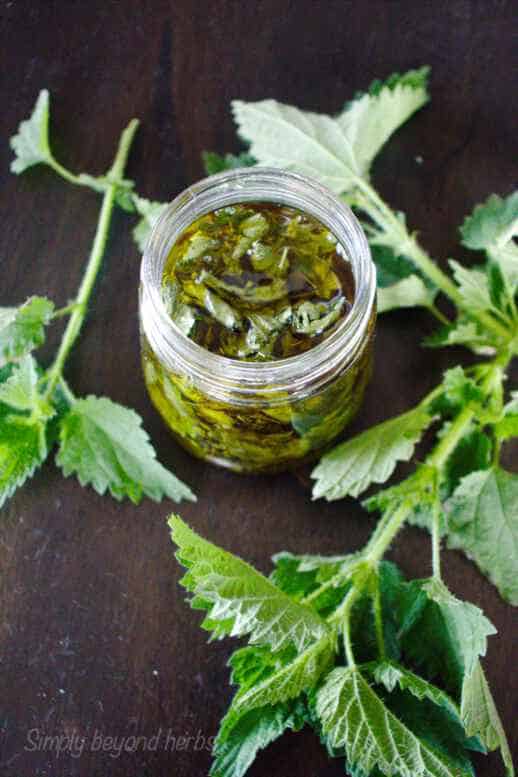
nettle oil benefits
Stinging nettle is rich in minerals such as magnesium, phosphorous, silicon, calcium, and iron. It also contains three times more vitamin C than broccoli and other vitamins A, E, B, and valuable enzymes and proteins.
We extract these valuable ingredients into an infused oil to boost hair growth and enhance hair quality. In addition, this oil enhances blood circulation, which is essential for hair roots to get a sufficient supply of nutrients.
Similarly also works sage infusion.
Nettle effectively relieves dry, tense scalp that usually contributes to alopecia (baldness).
It also contributes to hair re-growth, nettle leaves contain sulfur and silica that make the hair healthier and shinier.
A powerful herb, nettle possesses healing properties and helps with burns. This study confirms the high healing rate of nettle extract on second-degree burn wounds in rats compared to silver sulfadiazine and vaseline.
Nettle oil eases skin irritation on the scalp, including cradle caps in enfants or eczema.

Ingredients to make nettle oil
Stinging nettle leaves
While stinging nettle leaf eases arthritis, it is not a very pleasant experience to get stung.
One has to be careful when handling fresh stinging nettle leaves, as their barbs can inject various chemicals, such as histamine, serotonin, or formic acid, that can cause rashes or itchiness.
Luckily, these chemicals diminish when we process them by cooking, drying, grinding, or infusing them in oil.
If we intend to use the final product on the skin, the best practice is to infuse nettle leaves and stems in oil. This nettle infused oil that has multiple uses and applications.

Carrier oil
I have used extra virgin olive oil as a carrier oil that is rich in antioxidants and very good for normal skin. However, feel free to use any oil most suitable for your skin type. When I select a carrier oil for my project, I consider other factors, such as where I intend to use the final product or its absorption rate.
In fact, to double the nettle’s benefits, you may consider using nettle seed oil as a carrier oil, which is made from cold-pressed nettle seeds that also possess many medicinal benefits for the skin and hair.

How to make nettle oil?
First step
Wash the leaves thoroughly and place them in a sunny window to dry. When making infused oil, I prefer to use dry herbs as the moisture from fresh material can spoil the oil. It took me 2-3 days to dry them completely. You can also use a dehydrator to faster the process.
Second step
Once dried, grind the leaves between your fingers to make them into smaller pieces, and cut the stems. Smaller pieces make a better extraction.
Third step
Fill the sterilized glass jar with dried nettle

Fourth step
Pour over the extra virgin olive oil so all dried leaves are covered completely

Fifth step
Place it in the double boiler and bring it to simmer. Keep the heat slow for the nettle to relieve all its medicinal properties. Make sure you don’t exceed the temperature of 50 C (122 F) as most of the properties would be destroyed.

Sixth step
Strain the herbal material with cheesecloth and discard it. Store the pure nettle oil in a sterilized jar in a dark place away from direct sunlight.

Note: If you are not in a hurry, you can go for the slow traditional method, which doesn’t require a double boiler but time.
This method is straightforward and efficient, but you need at least four weeks to achieve your desired result. Fill the jar with dried leaves and stems.
Cover them with the oil of your choice, close the jar with a lid and place it in a warm spot for four weeks. Remember to shake it from time to time. The warm place helps the nettle to relieve its medicinal properties.
After four weeks, strain the oil from the herbal material and fill it into a clean and sterilized bottle. I used this method when making this highly scented lavender oil

How to use nettle oil
On hair
Massage the oil into your scalp and hair and leave it there for 2 minutes before rinsing it.
OR
Drip a few drops in your palm when applying shampoo or conditioner to your hair, and gently massage it into your hair and scalp.
You can achieve a better result by combining nettle oil topical application with the internal application of nettle root extract.
Apply rosemary or chamomile tea rinse afterward. Start from roots all the way down to the hair tips. You can also add apple cider vinegar or peppermint essential oil to the mixture to add flavor and use its ability to increase blood circulation. After the rinse, cover your hair with a towel and leave it to dry. Don’t wash it with water afterward. You can do it twice a week.

On skin
Add a few drops on your soap and massage your body. That will help clear up skin redness and irritation.
I used this nettle oil as a base for making nettle salve to ease inflammatory diseases such as dermatitis or arthritis.
Its healing power can help to heal burned or sunburned skin. Add a few drops to the burn gel before applying it to the affected area.
Apply on insect bites or use it as a carrier oil in this bug bite cream
Use oil as a base to make nettle lotion that promotes healthy skin and helps with skin irritations.
Nettle oil eases irritated skin, and free drops to your bath soothe and relax your skin.
It may also serve as a massage oil for your stiff joints.
Make these wonderful chocolate bath bombs with nettle oil.

Nettle oil is safe however, avoid using it if you are allergic or sensitive to nettle or other plants from the same family.
If stored in a cool, dry place without direct sun exposure, nettle oil can last up to one year.
How to make nettle oil

This soothing and moisturizing nettle oil may ease your stiff joints or enhance your skin and hair. Made of nettle leaves and carrier oil, this stinging nettle oil might help with skin irritations or baldness.
Tools
Instructions
- Grind dried nettle leaves between your fingers to make them into small pieces
- Fill the sterilized glass jar with dried nettle
- Pour over the extra virgin olive oil so all dried leaves are covered completely
- place it in the double boiler and bring it to simmer
- Simmer for 5 hours but make sure you don't exceed the temperature of 50 C (122 F)
- Keep the heat slow for nettle to relieve all her medicinal properties.
- strain the herbal macerate with cheesecloth
- store the oil in the sterilized jar in the dark place away from direct sunlight.
- Don’t forget to label it!
Notes
You can also go for the slow traditional method, which doesn’t require a double boiler but time.
This method is straightforward and efficient, but you need at least four weeks to achieve your desired result. Fill the jar with dried leaves and stems.
Cover them with the oil of your choice, close the jar with a lid and place it in a warm spot for four weeks. Remember to shake it from time to time. The warm place helps the nettle to relieve its medicinal properties.
After four weeks, strain the oil from the herbal material and fill it into a clean and sterilized bottle.
Recommended Products
As an Amazon Associate and member of other affiliate programs, I earn from qualifying purchases.
-
 Young4us Glass Funnel Set, 4 Pcs Lab Borosilicate Glass Funnels, 100mm (170mm Length), 75mm (130mm), 50mm (90mm) & 40mm (70mm) Diameter
Young4us Glass Funnel Set, 4 Pcs Lab Borosilicate Glass Funnels, 100mm (170mm Length), 75mm (130mm), 50mm (90mm) & 40mm (70mm) Diameter -
 More recipes with nettle leaves, seeds and root
More recipes with nettle leaves, seeds and root -
 Goodcook Cheesecloth, One Pack, White
Goodcook Cheesecloth, One Pack, White -
 Double Boiler with Silicone Spatula, 600ml Stainless Steel Melting Pot with Heat Resistant Handle for Melting Chocolate, Candy, Candle, Soap and Wax
Double Boiler with Silicone Spatula, 600ml Stainless Steel Melting Pot with Heat Resistant Handle for Melting Chocolate, Candy, Candle, Soap and Wax -
 Le Parfait Familia Wiss Terrine - 500ml Wide Mouth French Glass Mason Jar w/ 2-Piece Gold Lid, 16oz/Pint (Pack of 6)
Le Parfait Familia Wiss Terrine - 500ml Wide Mouth French Glass Mason Jar w/ 2-Piece Gold Lid, 16oz/Pint (Pack of 6)

Collection of infusion oils you might want to try
Collection of infusion oils you might want to try
DIY rose oil for skin and hair
This highly scented and effective rose oil is a must have item in your household. Our DIY rose infused oil goes a little bit further with ultra rich grape seed oil and petals from Rose Damascena.
How to make nettle oil
This mineral-rich nettle oil is a powerful remedy with a wide spectrum of uses from easing stiff joints to scalp and hair treatment. Made of nettle leaves this effective oil might help with skin irritations or baldness.
Scented Lavender infused oil
Infusion Lavender oil soothes minor skin irritations and eczema. It is also suitable for mild burns, yeast infections or for insect bites.
DIY Dandelion oil to heal your cracked hands
Dandelion oil is used in salves, lotions, and lip balms to soothe dry and cracked skin. Thanks to its capability to speed up the healing process of scars and calm down skin irritations dandelion oil is also efficient in acne treatment.
Uses and benefits of Calendula oil
Calendula (Calendula Officinalis, a.k.a. “Pot Marigold”) has its well-defined place in the herbal world. It’s not only the bright color and sweet smell that distinguish this plant from the others. But mainly it’s healing power and capability to cleanse wound made it internal as well as external number one choice of herbal healer.
How to make & use red clover oil
purple blossoms of the red clover make an outstanding nourishing oil that, by increasing collagen production, improves the elasticity of your skin and reduces wrinkles. Its anti-inflammatory properties can also help with eczema or psoriasis.
Powerful Elderflower infusion oil to soften your skin
Elderflower infusion oil has a powerful soothing effect on the skin, improves skin complexion and is especially useful for older skin. However, it is also very effective in treating acne or sunburns. It's anti-inflammatory and anti-wrinkle properties made the elderflower infusion oil very popular in the cosmetic industry.
How to make Rosehip oil to heal your skin
Packed with antioxidants and fatty acids, rosehip oil is a natural versatile moisturizer that will heal your hair, nails and skin from bruises, acne and wrinkles.
How to make Violet oil and its uses
Extracted from leaves and flowers of wild violets this violet oil possesses many benefits for skin and hair and might be also able to help with insomnia or rheumatic pain.
How to make chamomile oil
This soothing chamomile oil extracted from chamomile flowers deeply nourishes and restores the skin. Its healing properties can be used in wound healing, diaper rash, or eczema.
Cucumber oil recipe for skin and hair
Deeply moisturizing and nourishing cucumber oil soothes and protects dry skin and hair adding softness and hydration.
How to make lemon balm oil + 10 ways to use it
This soothing lemon balm oil moisturizes and promotes skin healing. Lemon balm oil’s healing properties may help with cold sores.

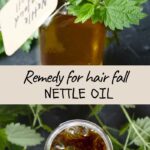

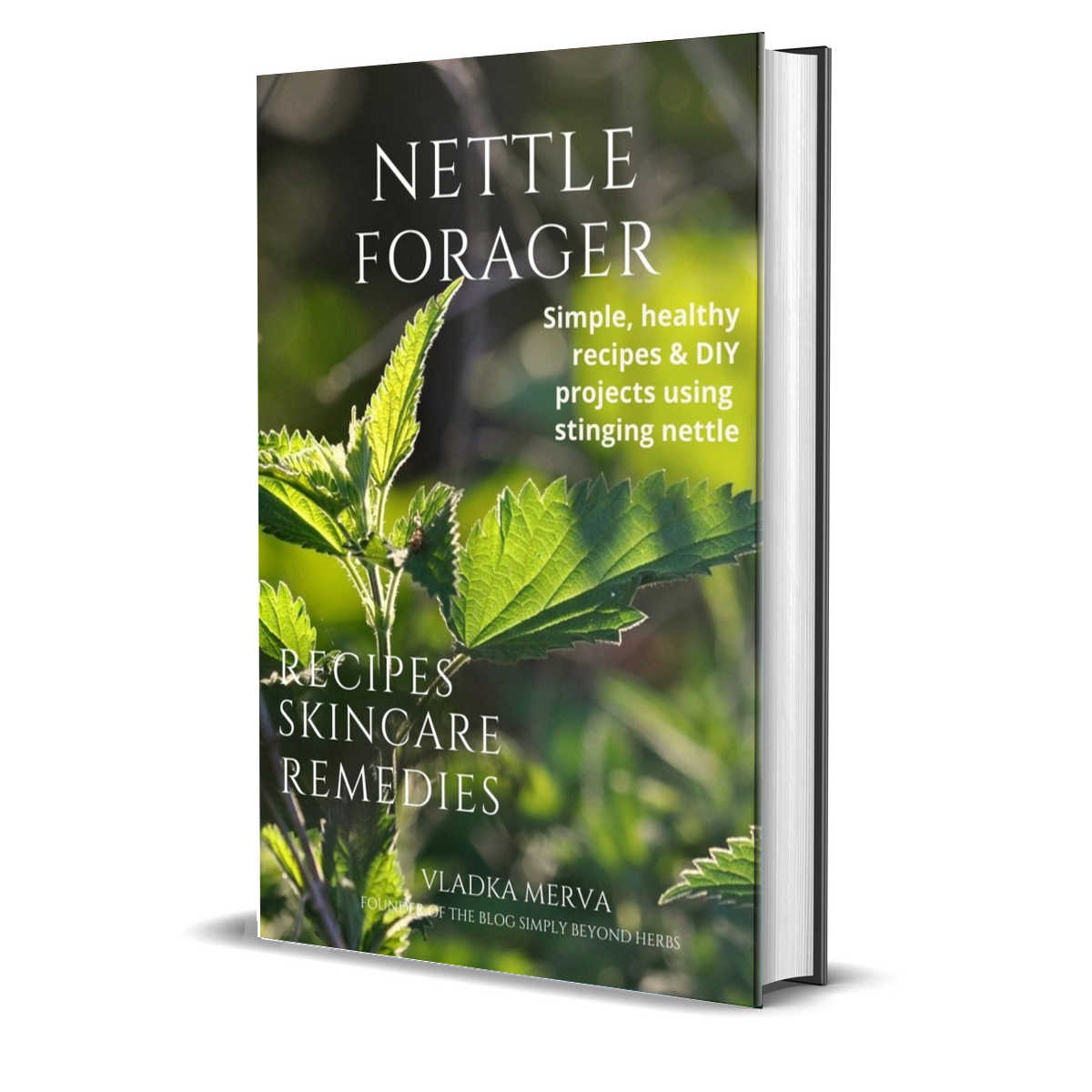



















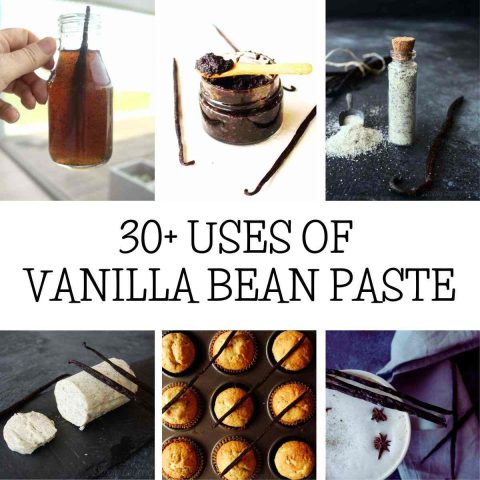

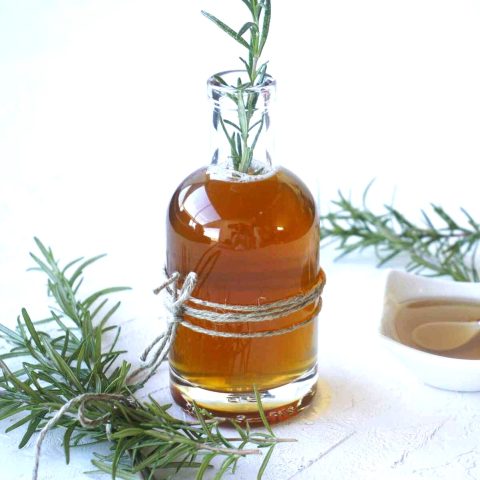


Thank you for this! My daughter has been battling scalp dryness and now her hair has started to fall out at alarming rates. We’ve analyzed her diet and health and are struggling to find a cause. Perhaps it’s a histamine response. At any rate, we’ll try this oil to see if it helps – the last of my nettle is still in the garden if the frost hasn’t gotten it!
I’ve used stining nettles for all sorts – including as sustainable fiber to spin with, but never for nails and skin. Thanks for this great resource – I think I’ll try it out. I love the fast infusion nethod too, although usually I only use for tough or woody herbs so I don’t lose too much of the goodness.
Thank you for the info! I am looking to add nettle leaf extract to my face oil. Do you know the safe percentage to work with, and how this would be added to the ingredient list? Looking forward to your nettle salve!
Thanks again 🙂
Dear Lauren, ethanol extract dissolves in oil if mixed properly. The ratio should be as follows:
75 – 80ml infused oil
10g beeswax
10ml extract
2 – 5 ml essential oil
Hope it helps. Share your result. Vladka
Thank you for this informative article. What is the best way to use the Nettle oil for hair loss? How long does the nettle oil take effect? I have a son with Alopecia and would like to try this to get his hair to grow back. Any advice would be appreciated.
Thank you
Great article, I am going to try to make this nettle infused oil as well. Just curious, you mentioned you were going to use it for hair loss, but then the article didn’t talk about it after. Did you end up seeing results with hair regrowth after applying it to your scalp? I would love to try this, but I’m also interested to know if you found it truly worked. Thanks very much!
Hi Dan, thank you for your lovely comment! 😊 I did use the nettle-infused oil on my scalp for a few weeks, and while I think my hair loss was mostly seasonal and temporary, I still noticed less shedding and stronger, shinier hair. It wasn’t an overnight miracle, but it definitely felt nourishing for my scalp. I used it 2–3 times a week, massaged in and left for a few hours (sometimes overnight) before washing. If you try it, I’d love to hear how it works for you!